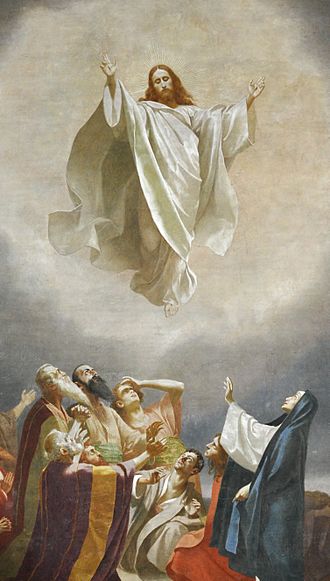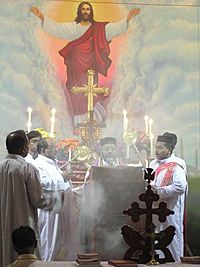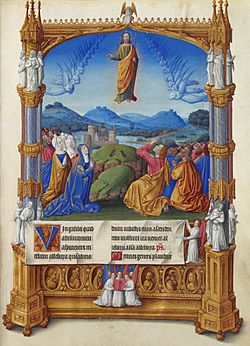Ascension facts for kids
Quick facts for kids Feast of the Ascension |
|
|---|---|

Christi Himmelfahrt by Gebhard Fugel, c. 1893
|
|
| Also called | Ascension Day Ascension Thursday Holy Thursday |
| Observed by | Christians |
| Type | Christian |
| Significance | commemorates the Ascension of Jesus into heaven |
| Observances | Service of Worship / Mass |
| Date | 39 days after Easter |
| 2025 date |
|
| 2026 date |
|
| 2027 date |
|
| 2028 date |
|
| Frequency | annual |
| Related to | Easter, Pentecost |
Ascension Day is a special Christian holiday. The word "ascension" means "going up." This holiday celebrates the story of Jesus going up to heaven. The Bible says that Jesus' closest followers, his apostles, saw him go.
Christians celebrate Ascension Day forty days after Easter. The story says that Jesus' body went to heaven. There, he sits at the right side of God the Father.
Ascension Day is usually celebrated on a Thursday. It is an important holiday for all Christians. It is celebrated much like Easter and Pentecost.
In many countries, Ascension Day is a public holiday. This means schools and businesses might be closed. Some of these countries include Germany, France, Belgium, and Norway. In Germany, Father's Day is also celebrated on this date.
Contents
How Christians Celebrate Ascension
Ascension Day is a very important day in the Christian Church calendar. It is one of the main holidays that all Christians celebrate.
Eastern Churches and Their Dates

The Eastern Orthodox Church figures out the date of Easter differently. Because of this, their Ascension Day is usually later than the Western Churches' celebration. It can be one, four, or five weeks later. Sometimes, it falls on the same day.
The earliest Ascension Day can be is May 13th. The latest it can be is June 16th. Some other Eastern Churches celebrate it on the same day as Western Churches. Many Eastern Churches celebrate with a special all-night prayer service.
What the Bible Says About Ascension
The Bible has several parts that talk about Jesus going to heaven. These texts help Christians understand the meaning of Ascension Day.
Early Christian Writings
One of the earliest mentions is in a book called the Epistle to the Romans. This book was written by Paul around the year 56 or 57. Paul describes Christ as being in heaven.
The Book of Acts
One of the most important stories about the Ascension is in the Acts of the Apostles (chapter 1, verses 1-11). This book says that Jesus was taken up into heaven. This happened forty days after he came back to life. The apostles saw him go. Before he left, Jesus gave them a message. He told them to share his teachings with the world. He also said that he would return one day.
Other Bible Books
- The Gospel of Luke says the Ascension happened on Easter Sunday evening.
- The Gospel of John talks about Jesus returning to his Father.
- The book of 1 Peter says Jesus went to heaven and is at God's right side.
- Ephesians mentions Jesus going higher than all the heavens.
- First Timothy describes Jesus being taken up in glory.
- The traditional ending of the Book of Mark also talks about Jesus going to heaven. It says he sits at God's right hand.
The way Jesus' Ascension is described in the Bible is similar to how important people were welcomed in heaven in older Hebrew scriptures. The idea of Jesus rising into the clouds fits with the old belief that heaven was above the earth.
Other Ancient Writings About Ascension
Some old texts not found in the official Bible also talk about Jesus' ascension. One example is a text called Pistis Sophia.
Another writer named Irenaeus wrote about different ideas. He mentioned that some groups, called Gnostics, believed Jesus' Ascension happened eighteen months after he came back to life. Another old text, the Apocryphon of James, suggests an even longer time. It describes Jesus teaching his followers 550 days after his resurrection, but before he went to heaven.
However, some important texts, like the Gospel of Thomas, do not mention the Ascension at all.
The History of Ascension Day
The Feast of the Ascension has been celebrated for many centuries. We don't have written records of it before the 400s. But a famous Christian leader, St. Augustine, said it was a very old tradition. He believed it came from the Apostles themselves. He wrote about it in a way that showed all Christians celebrated it long before his time (he lived from 354 to 430 AD).
The idea of Christ's ascension is also in the original Nicene Creed. This is an important statement of Christian beliefs made in 325 AD. It is still used in church services today. It is also mentioned in the Apostles' Creed. The Ascension is important because it shows that Jesus' human body was taken into Heaven. This means that human nature can be with God.
There is a lot of proof that this holiday has been celebrated since at least the late 300s.
Images for kids
See Also





